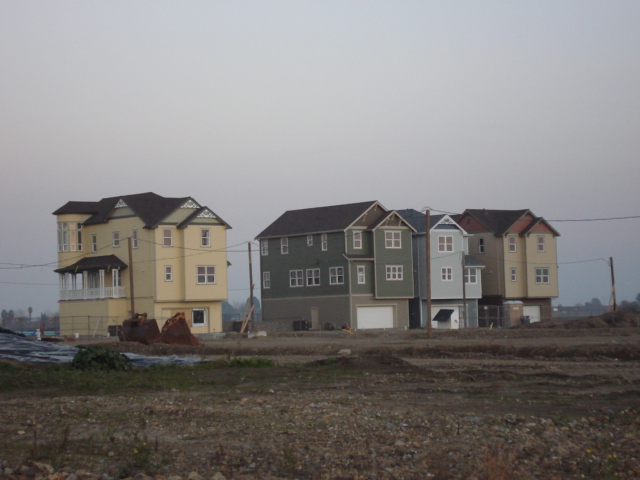Growth On Stilts Submitted by Bill Fulton on 21 January 2008 - 1:43pm Sacramento may be flooded with red ink these days – after all, the state’s grappling with a $14 billion budget deficit – but that’s not the only immersion the locals are talking about. As the feds get tougher about flood hazards, should the city go back to living on stilts, as it did in the old days? California’s capital city is one of the most flood-prone metro areas in the nation – and Sac-town’s characteristic state of denial got harder to maintain last week, when the Federal Emergency Management Agency announced it would designate the Natomas area as a flood hazard zone. That designation – long forestalled by the efforts of Sacramento’s congressional delegation – will require residents to get flood insurance and could well force a de facto building moratorium. Mayor Heather Fargo, who’s currently running unopposed for re-election, has been complaining about FEMA and as a result is getting hammered in the local paper for supposedly putting the city’s development plans over public safety. Congresswoman Doris Matsui has said she’s not going to try to overturn FEMA – something Bob Matsui, her predecessor and late husband, did successfully back in the ‘80s. There’s no doubt that the FEMA move puts Sacramento in a tough position. Located on the north side of the American River, between downtown Sacramento and Sacramento International Airport, Natomas is just about the last undeveloped area in the City of Sacramento. It’s the home of Arco Arena, where the Sacramento Kings basketball team plays. Development was held up for many years in the 1990s because of flood concerns but in the recent housing boom it’s been a cash cow for Sacramento developers, and the city. During recent years, about half of the new housing in Sacramento has been built in Natomas, and a lot more development is in the pipeline. So what’s a flood-prone city to do? Maybe Sacramentans should go back to building houses the way they used to – and, apparently, the way their Delta neighbors are beginning to do again. Back in the 19th Century, most Sacramento houses were built on the assumption that the ground floor would flood sooner or later. Sure, there was a ground floor. But the main floor was actually the second storey, and the main entrance was a stairway from the street up to the second floor. Many of these old houses still exist, especially in the Midtown neighborhood of Sacramento. Should the flood-prone Sacramento area go back to building houses that start on the second floor? Actually, it’s already happening. One of the standard infill housing types throughout California today is the tall, skinny three-story residence (either a townhome or a  Although they look odd, these new houses with raised living spaces in Isleton may provide a model for flood-prone Sacramento. Although they look odd, these new houses with raised living spaces in Isleton may provide a model for flood-prone Sacramento. single-family house designed like a townhome) with a garage on the ground floor and living space on the second and third floor. It’s practically infill on stilts. I’ve seen these projects all over the place. There’s one about a block from our office in Downtown Ventura. But the flood-resistant nature of this particular housing type didn’t really strike me until Saturday, when I stopped by the Delta town of Isleton – 30 or so miles down the Sacramento River south of the capital – and checked out the first new subdivision built in the city in something like 80 years. The old Delta cities in this area – Isleton, Walnut Grove, Locke – are tightly laid out in the late 19th Century style, and they’re separated from the river by a major levee, which doubles as a road. In Walnut Grove, some of the buildings have a ground floor that fronts on a downtown street and a second storey that fronts on the levee road. But this new dev Weird-lookin’? Yeah. But flood-proof for sure! So maybe Mayor Fargo could blunt some of the criticism she’s been getting by adopting the Isleton approach. After all, does it really matter if you car floods – so long as your living space is high and dry? -- Bill Fulton »
|
Sunday, September 26, 2010
Palomino & Sons inc.
Subscribe to:
Post Comments (Atom)
Wow husband havent seen these homes forever!Please call me
ReplyDeleteIm gonna be moving as you did and i didnt know you were lying is not good maybe you can blog on how to be a good husband and not cheat leaving your family behind is not right being honest is a call is not gonna hurt you!You have someone so why hide be happy piss face!Im all alone 20 years but i will go on as you did
ReplyDelete